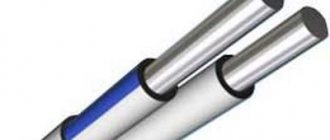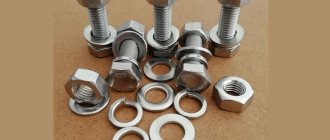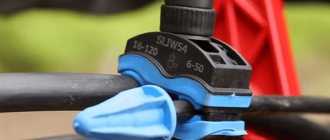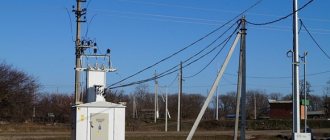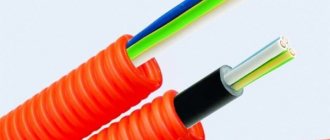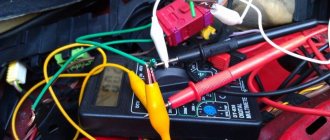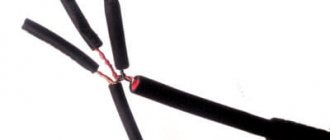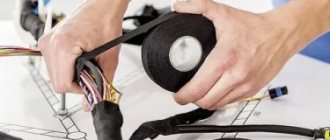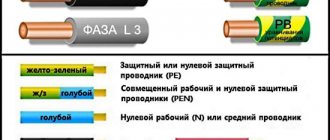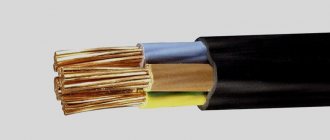What is the difficulty of connecting copper and aluminum wiring directly
As is known, the cause of problems in the direct connection of copper and aluminum is electrocorrosion processes. In a dry environment, nothing will happen even with direct contact, but with increased humidity, a short-circuited galvanic cell is formed at the junction, in which the metals begin to play the role of a battery with a “plus” and a “minus”. The metal itself practically melts, resulting in a network rupture with a possible short circuit and insulation fire. Which in turn can lead to a fire.
In order to avoid this, various types of contact devices are used to indirectly connect copper and aluminum wiring.
All connection methods can be divided into 2 groups based on the presence of wire contact:
- There is direct contact between the wires: twisting, crimping, connection with rivets, strips.
- There is no direct contact between the wires: threaded fixation, connection with various types of terminal blocks.
Important! To connect aluminum and copper wires, it is recommended to use methods from the second group. It is allowed to use connections from group 1 provided that the copper wire is processed. For example, it can be tinned with solder.
WAGO terminal blocks
WAGO clamps consist of a self-clamping metal plate treated with anti-oxidation paste and a dielectric housing. Aluminum and copper wires are inserted into adjacent holes and pressed against one plate. Thus, the materials do not come into contact with each other and do not oxidize.
WAGO clamps are used mainly for groups of lighting devices, since with a high current load the plate can often burn out and the clamp itself can melt. Please note that the maximum cross-section of wires for WAGO clamps is 2.5 mm2, so we do not recommend installing a core thicker than this.
The advantage of WAGO terminal blocks is the speed of installation and compact dimensions, thanks to which the connections can be easily installed in the junction box. However, WAGO is quite expensive in terms of cost, and with a large number of connections it will cost its owner a pretty penny.
Twist
The main method of connecting wires at home, it is quite convenient in that it does not require special tools and equipment. But in the case of connecting aluminum and copper wires, this method must be used extremely carefully, observing the following conditions:
- A twisted connection is made by mutually twisting both ends of the wire with each other; wrapping the end of one wire around the other is not allowed;
- It is recommended to tin the copper cable with tin or solder before twisting; this point is especially important for stranded copper wire;
- A protective moisture-resistant coating must be applied to the connection between aluminum and copper wires.
There are three main types of twist: simple, bandage and groove twist. It should be noted that bandage twisting will give the best results. When performing twisting, it is worth considering that the number of turns directly depends on the diameter of the wiring, so for a wire up to 1 mm in diameter it is necessary to make at least 5 turns, for large sections at least three turns. In addition to moisture insulation, one should not forget about the electrical insulation of the twist; for this you can use special tips.
Twisting methods
High-quality twisting will last quite a long time, but only the use of an indirect connection can provide a true guarantee.
How to make a twist correctly
First you need to prepare the ends of the wires. To do this, remove the insulation at a distance of 3–5 cm from the edge of the cable. It should be noted that the heat-shrink tube is placed on one of the wires, before twisting, upon completion of all operations, the tube is moved to an open place and fixed there. After cleaning the ends, you need to twist the wires according to the proposed diagram. In this case, it is necessary to ensure that the cores are wrapped around each other, and that one cable core does not overlap another.
To make it easier to twist a multi-core copper cable, its cores can and should be tinned. It should also be noted that tinning copper in any case increases the reliability of the twisted connection. After twisting, the connection point must be coated with moisture-resistant varnish. Electrical insulation can be done using heat shrink tubing or cap caps with a soft clamp or cone spring.
Insulation of wire ends with caps with a cone spring
Important! Unless absolutely necessary, it is not recommended to use twisting to connect copper and aluminum cables. Currently, there are many safer and more reliable ways to combine copper and aluminum into one network.
Connection recommendations
Why is it strictly forbidden to connect copper and aluminum wires directly? Aluminum is a highly oxidizable metal. This is the process of formation of an oxide film on its surface, which has a very high resistance, which naturally cannot but affect the conductivity of such a connection. Copper wires are less susceptible to oxidation, or rather, the oxide film on them has much less resistance than the oxide film on aluminum wires, so this affects the current conductivity very little.
Therefore, when connecting copper and aluminum wires, electrical contact actually occurs through oxide films of copper and aluminum, which have different electrochemical properties, which can significantly impede current conduction at this junction. On the street, under the influence of precipitation and the passage of electric current through the connection, the process of electrolysis occurs. The result is the formation of shells at the junction, heating and sparking of the contacts - an increased fire hazard of the joint.
- There are the following options for connecting copper and aluminum wires:
- Connections of copper and aluminum wires outdoors or indoors are allowed only with the use of special adapters - terminal blocks. A good solution for outdoor connections would be to use branch clamps for SIPs (“punctures”) with a paste that protects the surface of the wires from oxidation.
- A good option is branch clamps (“nuts”) - the wires in them are connected through an intermediate plate inside, i.e. direct contact of copper with aluminum is excluded.
- Indoors, it is advisable to use Wago self-clamping terminal blocks with a paste that prevents the oxidation of aluminum wires. This is a quick way to connect copper and aluminum wires and does not require additional insulation. Due to their small size, self-clamping, screw or spring terminal blocks are very convenient for connecting wires in junction boxes.
- Finally, if you don’t have a terminal block or “nut” at hand, there are different situations, it is much safer, instead of the usual twisting of copper and aluminum wires, to tighten them with a bolt and nut, placing a washer between them, which will prevent direct contact of copper and aluminum. In terms of contact reliability, such a connection will be inferior to manufactured terminal blocks or “nuts”, except that it is bulkier - it is more difficult to place it in a junction box. When using this method, it is also worth noting the need for good insulation of the connection.
Using twists or terminal blocks
When connecting conductors, many important factors must be taken into account: the material of the current-carrying cores of the switched wires, their electrochemical compatibility or incompatibility (in particular, copper and aluminum), wire cross-section, twist length, network load, etc.
However, the regulatory documents regulating the rules for performing electrical installation work, in particular the PUE (Electrical Installation Rules), clearly state the prohibition on connecting wires using the twisting method: PUE: clause 2.1.21. Connection, branching and terminating of wires and cables must be carried out using crimping, welding, soldering or clamping (screw, bolt, etc.) in accordance with current instructions.
As you can see, the PUE allows only 4 types of wire connections, and twisting is not among them (except for cases when the twisting is preliminary, for example, before soldering or welding). Therefore, endless debates and discussions about the advantages or disadvantages of twists lose all meaning, because not a single fire inspector will approve an electrical installation if its wires are switched using twists.
Soldering or welding significantly increases installation time; this procedure is much longer than using terminal blocks - you need to remove the insulation from the wires, tin the wires, if it is soldering, connect the welder, then insulate all the wires. If it is necessary to reconnect the wires (for example, add a wire), there are also difficulties - removing the insulation, soldering (cooking) again. With terminal blocks everything is much simpler, but better contact is achieved using welding or soldering.
There are different types of terminal blocks suitable for connecting electrical wires in an apartment or house.
- Here are the main and most common among them:
- Self-clamping terminal blocks can have from 2 to 8 places for wires with a minimum cross-section of 0.75 mm2 and a maximum of 2.5 mm2. Capable of withstanding loads up to 4-5 kW (24 A). Such terminal blocks are very convenient to install, greatly reducing installation time - there is no need to twist and then insulate the wires. But, they take up more space in solder boxes, unlike twists, which can be given any shape, laid out, bent in any way.
- Connecting screw terminal blocks are designed to connect wires to each other. Typically used for switching wires in distribution boxes. Material: polyethylene, polyamide, polycarbonate, polypropylene. It is better not to use such terminal blocks for aluminum wires - in screw terminal blocks they are severely deformed and can be broken.
Insulating connecting clamps (PIC) are used to connect single-wire cores of wires with a total maximum cross-section of up to 20 mm2 and a minimum cross-section of 2.5 mm2. They have an insulated casing made of polyamide, nylon or fire-resistant PVC, so that the wires do not require further insulation, into which an anodized conical spring is pressed.
When connecting the wires, the insulation is removed from them (10-15 mm), collected into one bundle and the PPE is screwed onto them (clockwise) until it stops. PPE caps are very convenient and easy to install, but they are much inferior to terminal blocks in the quality of twisting, so it is still better to give preference to terminal blocks.
Crimping
In this case, a metal or plastic sleeve or tip is placed on the twisted connection, which is fixed to the connection with press pliers, a special crimping tool. Fixation in this case is carried out by crimping the connection with the sleeve material. The sleeves are a metal tube with insulation made of PVC materials. The nozzles are usually plastic caps into which the compound is inserted, after which the cap is crimped with press jaws.
Separately, it is necessary to note the connection using cap attachments with a clamping ring or cone spring. In this case, after twisting the wires, a cap is put on the twist, after which it is screwed onto the connection with rotational movements, after which it is simply crimped with pliers. In this case, a ring of soft metal inside the cap tightly compresses the junction. This crimping option is quite accessible for household use.
Crimping
Stranded wires
As mentioned earlier, conductors with many cores should not be overly pinched. To connect stranded wires, sleeves or ordinary twists are most often used. We'll talk about these methods in a little more detail below.
Sleeves
The sleeve is a protective cap made of plastic, under which there is a hollow metal tip. First of all, it is necessary to remove the insulating layer from the conductor. Next, the strands are twisted into one whole, and the resulting “pigtail” is directed into the sleeve. Next, the sleeve is crimped (pliers are suitable for this operation). The tip of the sleeve is inserted into the terminal. To increase the reliability of the connection, the sleeve can be treated with solder.
Threaded fixation
A reliable, although somewhat cumbersome, way of connecting copper and aluminum wiring is a threaded connection; in this case, the cores are clamped with a nut on a threaded base. In order to avoid direct contact, a washer is placed between the exposed ends of the cores.
The advantages of this connection method are simplicity and versatility. In this way, you can connect several electrical wires of different cross-sections. But at the same time, this type of connection is quite cumbersome, and it is also very inconvenient to isolate. But, at the same time, this type of connection requires only a bolt and nut.
First of all, the ends of the wire are prepared. The insulation is removed at a distance of 1–1.5 cm from the cut, after which rings with a diameter slightly larger than the diameter of the bolt or rivet are made from the exposed wires. These rings are used to attach the wire to the rivet or threaded part of the bolt. A spring washer is placed between the aluminum and copper cable; this is necessary to ensure that there is no direct contact between these metals. After which the connection is fixed by tightening the nut or a riveter.
It is worth noting that this option is suitable for splicing wires of sufficient length; when saving length, which is often found when connecting lighting electrical equipment to the short ends of an aluminum wire, as is often the case in old apartments, it is better to use terminal boxes.
Threaded connection
What problems may arise when joining aluminum and copper?
Not so long ago, electrical wiring in an apartment or private house was made of aluminum wire, since it was enough to provide power to all the few existing electrical appliances. With the development of the world of electronics and home appliances, there has been a tendency to increase the load on electrical circuits. Accordingly, the need arose to connect the old and new wiring.
When aluminum and copper touch, a chemical reaction occurs, which subsequently worsens the electrical contact, the connection point begins to heat up and can ultimately cause the wiring to catch fire and even a fire. With increased ambient humidity, this process occurs quite quickly, since a thin film with high resistance forms between the conductors, resulting in heating and circuit breakage. But still, every electrician knows how to connect an aluminum wire with a copper wire in order to avoid an unpleasant situation in the future.
The video below clearly shows the consequences of unsafe contact between copper and aluminum:
In any case, it is recommended to replace the old wiring with copper wiring, which will have a load capacity corresponding to the current consumption of electrical appliances. If it is not possible to completely replace the wiring with a new one, then perform a partial replacement of the wiring. In this case, it becomes necessary to connect the old and new electrical wiring - copper and aluminum wires.
Connecting copper and aluminum wires with rivets
The clamping of the wires in this case is carried out by a wedged rivet, consisting of a tube and a core, fixed with a rivet gun. To connect, prepared conductors with wound rings are placed on a rivet tube with a gasket - a steel washer. After which the rivet is crimped with a rivet tool, the core wedges the rivet tube, thereby compressing the metal cores among themselves, thereby fixing the cable cores.
The contact in this case is permanent, but at the same time strong and reliable. For this type of connection, you need a special tool - a riveter, and skills to work with it. This method is used mainly for working with wire breaks and splicing wire ends in hard-to-reach places.
Riveter and rivets
Methods for connecting different wires
There are several basic generally accepted common devices that make it possible to eliminate direct contact between two materials that act aggressively on each other. Let's look at each separately.
Terminal blocks
Terminal blocks can be equipped with a bolted or clamped connection mechanism. This design allows connection to one terminal of aluminum and to the other of copper conductive material, which are in contact with each other through a steel plate. The plate is made of a neutral metal that does not react with copper and aluminum - usually brass plates or tinned copper plates. For example, with the widely used Wago 2273 terminal, you can simultaneously connect from two to eight conductors of different cross-sections and mount them on a DIN rail using a special mounting adapter.
The bolt clamp in the blocks is more reliable and is used in non-high-voltage power circuits. Most often it is carried out using a “nut”. This is a small junction box made of dielectric material, shaped like a walnut, inside which there is a block of metal plates through which contact occurs between aluminum and copper wires. All of these methods described above relate to detachable connections, that is, for reusable connection and disconnection, if necessary.
The example clearly shows the bonding of copper and aluminum in a junction box through the use of brass terminal blocks:
Read about how to connect wires with WAGO terminals in our separate publication!
Crimping method
Sometimes, when laying and installing electrical wiring, it becomes necessary to make a high-quality permanent connection of copper and aluminum wires by crimping using sleeves. More often it occurs at the entrance to an electrical cabinet, switchgear, or when connecting a cable to an already installed unit, where it is impossible to replace aluminum with copper, and vice versa.
This type of connection of conductors is more expensive, as it requires special tools. But at the same time, when carrying out numerous installation works of this type, professionals often choose it.
Crimping wires with sleeves ensures more reliable and durable contact. This method is used in production to fasten copper and aluminum conductors even to particularly powerful and high-voltage consumers. To perform this work, you need a special tool and special copper-aluminum sleeves. They can be compressed even using a regular hammer and metal pads, which is not entirely correct, or there is a professional manual hydraulic press.
It is recommended to use this compression not only when crimping sleeves, but also tips. By the way, they can also be made half of copper and aluminum, for connecting, for example, an aluminum cable to any device with copper leads or terminals.
Typically, aluminum-copper sleeves are used to connect large cross-section cable cores. For small cross-sections, for example, in home electrical wiring, several conductors are crimped with one sleeve. In this case, the wires are brought in from different sides, to connect as if at a joint, as shown in the photo above. You cannot stack aluminum and copper conductors parallel to each other (overlapping), as shown in the illustration with a hydraulic press, because in this case direct contact between aluminum and copper occurs. Also, you cannot use bare copper sleeves with aluminum cable.
Bolted connection
Very often, when working with electrical wiring, an ordinary person who is not involved in electrical work at home may have an urgent need to create good and reliable contact between the aluminum and copper wire. Running to the store to buy special tools and materials is not advisable when performing one-time jobs, but they need to be done and at the same time with high quality.
Then it makes sense to use a regular bolt with a nut and several washers. The main thing in this method is to separate two metals that are aggressive towards each other with washers, as shown in the figure below.
The bolted connection of aluminum and copper wires can be made in a distribution box, which is an integral part of any wiring both in the house and in the apartment. Thus, even wires with different cross-sectional cross-sections can be easily and efficiently connected through the bolt.
The wire rings should be turned in the direction of tightening the nut when connecting with a bolt. This is necessary so that when tightened, the rings do not unwind and increase in diameter, but rather wrap around the bolt more tightly.
The video clearly shows how to connect cores of different materials with a bolt:
A similar method is to use a riveter. Below clearly shows how to connect wires with a rivet:
There is also the option of using aluminum-copper tips and aluminum-copper washers. You can crimp an aluminum cable with a lug and connect it to a copper busbar. Or, when using an aluminum-copper washer, you can crimp the aluminum cable with a regular aluminum cable lug and connect it to the bus through this washer.
Connection with two steel strips
You can connect copper and aluminum wires in this tricky way, which also requires pre-treatment of the copper wire with tinning: clamp the wires with two steel strips with bolts at the edges. Advantages of the method: the ability to connect several branches of wiring at once, without increasing the length of the bolt. In this case, the bare ends of the cores are placed between the slats. The method is applicable for wires of the same cross-section.
Important! The connection with two steel strips requires mandatory external insulation, as well as preparation of the copper wire by tinning.
Wire clamp with metal plate
Walnut clip
Another good way to connect copper and aluminum wires is to use nut clamps. It is more correct to call this device a branch compressor. It was already the electricians who nicknamed it “the nut” because of its external resemblance.
It is a dielectric polycarbonate housing, inside of which there is a metal core (or core). The core is two dies, each of which has a groove for a certain cross-section of the conductor, and an intermediate plate, all of which are connected to each other with bolts.
Such clamps are sold in any electrical goods store; they have different types, which depend on the cross-section of the wires being connected. The disadvantage of such a device is that it is not sealed, that is, there is the possibility of moisture, dust and even small debris getting in. For reliability and quality of connection, it is better to wrap the “nut” with insulating tape on top.
The process of connecting wires using this compression is as follows:
- Disassemble the compression housing; to do this, pry up and remove the retaining rings using a thin screwdriver.
- On the wires to be connected, strip the insulating layer to the length of the dies.
- Unscrew the fixing bolts and insert the exposed conductors into the die grooves.
- Tighten the bolts, position the die in the compression housing.
- Close the housing and install the retaining rings.
A practical example of using a nut clamp is shown in this video:
Terminal blocks and terminal boxes
Convenient and reliable connection method. The terminal block is a strip of insulating material in which sockets for wires are located. The wires are fixed in the sockets using clamping bolts. An important feature in our case is the absence of contact between the wires. To connect copper and aluminum wires, you only need a screwdriver.
The terminal box is a system of several separately located terminal blocks, combined into one structure and having several terminals.
Terminal box
The advantages of this connection method are:
- Easy to install, all you need is an electrician's knife to strip the ends of the wire and a screwdriver to tighten the screws;
- Reliability of insulation, very often when using a terminal block or terminal box, additional insulation is not required;
- Undemanding to the length of the wire; 1–2 cm of wire is enough to fix the wire in the terminal box.
At the same time, to install hidden wiring in the wall, the terminal block requires the installation of a distribution box. Without a distribution box, installation of hidden wiring is unacceptable. But in this case, you can use a terminal box for flush mounting.
When working with the terminal box, it is important to carefully fix the ends of the wire in the socket, especially for aluminum wires. This is especially important when installing the box outdoors or indoors where temperature fluctuations are possible.
Terminal block
A cheap and simple solution to the question of how to connect aluminum wires to copper wires is the use of terminal blocks. Buying them now is not a problem at all; moreover, you can buy not a whole section, but ask the seller to cut off the required number of cells. Terminal blocks are sold in different sizes, depending on the cross-section of the conductors connected to them.
What is such a block? This is a transparent polyethylene frame designed for several cells at once. Inside each cell there is a brass tubular sleeve. From opposite sides, the ends of the wires to be connected must be inserted into this sleeve and clamped with two screws.
The use of terminal blocks is very convenient because you can always cut off exactly as many cells from it as there are pairs of wires that need to be connected, for example, in one junction box.
Using the terminal blocks is very simple:
- Unscrew one clamping screw, thereby freeing one side of the sleeve for the conductor to pass into it.
- On the cores of the aluminum wire, strip the insulation to a length of 5 mm. Insert it into the terminal, tighten the screw, thereby pressing the conductor to the sleeve. The screw should be tightened firmly, but do not force it too hard, so as not to break the core.
- Do the same operations with the copper wire, inserting it into the sleeve from the opposite side.
Why do you have to do everything one by one? You can immediately unscrew two screws, insert the wires and tighten them. This is done to ensure that the copper and aluminum wires do not touch each other inside the brass sleeve.
As you can see, the advantages of terminal blocks are their ease and speed of use. This connection method is a detachable one; if necessary, you can remove one conductor and replace it with another.
Terminal blocks are not entirely suitable for connecting stranded conductors. In order to do this, you must first use ferrules that will crimp the bundle of cores.
There is one more feature in the use of terminal blocks. Under screw pressure at room temperature, aluminum can flow. Therefore, periodic inspection of the terminal and tightening of the contact connection where the aluminum wire is fixed will be required. If this is neglected, the aluminum conductor in the terminal block will become loose, the contact will weaken, begin to heat up and spark, which may result in a fire.
How to connect wires using a terminal block is shown in this video:
Connection with spring and self-clamping terminal blocks
Currently, both reusable and single-use terminal blocks and terminal blocks are produced.
- spring terminal blocks and reusable terminal blocks have a retaining spring that can be loosened by lifting a lever located on the device body. This allows you to remove or insert the wire without any effort. Lowering the lever securely fixes the cable cores;
- Single-use terminal blocks automatically clamp the wire when inserting it into the socket; removing the wire will require physical force, which can damage the clamping spring, so their single use is recommended.
Both reusable and single-use terminal blocks are produced in a wide range, including with a different number of connected wiring branches, designed to fix wires with a cross-section from 0.08 mm² to 6 mm². Including in the form of ready-to-install terminal boxes. This method of connecting aluminum and copper wires is currently the most optimal in terms of reliability and ease of use.
Section of the spring terminal block and placement of the connection in the junction box
Terminal boxes with spring clamps were first produced by the German company Wago, from which they got their name, but currently there are a large number of analogues, including counterfeit ones. For this reason, it is necessary to purchase spring terminal boxes only from electrical stores. When purchasing terminal boxes on the market, there is a high probability of purchasing low-quality products that do not meet the stated requirements.
Self-clamping terminal block WAGO
To fix the wires in the terminal box, it is necessary to prepare the wires; to do this, remove the insulation from their ends; the size of the exposed part must be at least 0.5 cm. After that, the open part of the cable core is inserted into the desired socket of the terminal box and fixed in it using a spring clamp or screw. It should be noted that mounting in a terminal box usually does not require additional insulation, but at the same time, when they are located in a wall, a distribution box is required. Thus, spring terminal blocks have a number of advantages over other types of connections due to ease of connection.
Self-clamping terminal block
Bolted connection
Bolted connection of aluminum wires to copper is considered the most affordable, simple, fast and reliable. To get started you will need a bolt, a nut, some steel washers and a wrench.
Of course, it is unlikely that you will be able to use this method to connect wires in an apartment junction box, because now they are produced in miniature sizes, and the resulting electrical unit will be very bulky. But if there are still Soviet-era boxes in your house or when you need to make a connection in a distribution panel, then this bolted method is best suited. In general, it is considered an ideal option when it is necessary to connect completely incompatible conductors - with different cross-sections, made of different materials, multi-core with single-core.
It is important to know that using the bolt method you can connect more than two conductors (their number depends on how long the bolt is long enough).
You will need to do the following:
- Strip each connected wire or cable from the insulating layer by 2-2.5 cm.
- From the stripped ends, form rings according to the diameter of the bolt so that they can easily be put on it.
- Now take the bolt, put a washer on it, then a ring of copper conductor, again a washer, a ring of aluminum conductor, a washer and tighten everything securely with a nut.
- Insulate the connection using insulating tape.
The most important thing is not to forget to place an intermediate washer between the aluminum and copper wires. If you will connect several different conductors, then you do not need to place an intermediate washer between the cores of the same metal.
Another advantage of this connection is that it is detachable. At any time you can unwind it and, if necessary, connect additional wires.
How to properly bolt a wire connection is shown in detail in this video:
conclusions
In this way, it is quite possible to connect copper and aluminum wire, but it is necessary to take into account the location of the cable and the environment. Copper and aluminum can only be connected by twisting in a dry room. If the humidity in the room increases, this connection may become unusable and, moreover, cause a fire. The most optimal method today is to connect electrical wiring using spring terminal blocks.
The main advantage of this method is stable fixation in any environmental conditions. Despite all the advantages of a screw terminal block, threaded or rivet connection, when operating under conditions of sudden temperature changes, the contact under the screw may weaken. Due to the difference in temperature expansion of the metals of the wires. These changes may result in loss of contact or short circuit. Thus, with all the variety of methods for connecting copper and aluminum wiring, the safest method at the moment is the use of self-clamping terminal blocks.
Why you can't connect copper and aluminum directly
To do this, you should strain your memory and remember the school course in chemistry and physics. To begin with, let's remember what a galvanic cell is. Simply put, a galvanic cell is a simple battery that generates electric current. The principle of its appearance is based on the interaction of two metals in the electrolyte. So, the twist between the copper and aluminum wire will be the same battery.
Galvanic currents quickly destroy the material. True, in dry air their appearance is excluded. And if you twist it to the socket, it will not fall apart in a few hours. However, later troubles with such wiring are guaranteed.
Over time, the materials from which the wires are made deteriorate, and along with this, the resistance constantly increases. If a powerful current consumer is connected to the outlet, the twist will begin to heat up.
Regular use of such an outlet increases the risk of fire. Therefore, connecting an aluminum conductor to a copper conductor is strictly prohibited. However, emergency situations arise when making such a connection is simply necessary.
How to connect aluminum wires
There are different methods that are used depending on the situation, taking into account the positive and negative qualities of each of them.
Twist
This is a simple way to connect wires, but if the twist is done incorrectly, it will not be very reliable.
The procedure is as follows:
- Remove the insulation at a distance of 4-5 cm from the edge.
- Degrease the contacts and remove the oxide film from them with sandpaper.
- The veins are crossed with each other and the fabric is twisted into a rope using pliers.
- Protect the contact with heat shrink tubing.
The technology for such a connection is simple, but in order to get good contact, the work is performed only with pliers, because You won't be able to twist the wires tightly by hand.
Welding
This method allows you to create a single whole at the point of contact, so there is practically no transition resistance there, and the pressing force is reduced.
There are also some disadvantages:
- The presence of an oxide film on the surface of Al, which complicates the welding process, since the melting temperature of the coating is much higher than that of the metal.
- Due to the difference in the melting temperatures of the metal and the oxide film, welding with a carbon electrode will not work: oxides will remain in the metal drops, and the connection will be fragile.
Removal of oxides is carried out mechanically, but this work requires a lot of physical effort and is ineffective, because they form again almost immediately. The use of special fluxes helps to destroy the film, but it is difficult to select them at home.
You won’t be able to weld aluminum yourself without proper training. Here it is important to accurately select the operating voltage (within 20 V) and the time of exposure to the metal (1-2 seconds).
Spike
This is a labor-intensive and time-consuming process. It is practically not used in power networks, and copper wiring is now more often installed in houses and apartments.
When performing soldering, problems are also associated with the presence of an oxide film. In addition, there is no way to control the heating of the wire, and with prolonged exposure to high temperatures, aluminum changes its characteristics.
Removal of oxides is carried out with sandpaper or other abrasive materials. The oxide film quickly forms again; it is impossible to completely remove it, but it is possible to reduce the thickness of the layer.
The cores are connected to each other, then they are touched with a heated tip of a soldering iron with solder and flux. The latter destroys the oxide film well, and to make it perform its task even better, solder is scraped along the wires. If the work is done without flux, then rub the solder at the contact point more intensively.
Electrochemical corrosion
When wires come into contact, the main cause of their destruction is electrochemical corrosion. If aluminum conductors are in contact with each other or with other metals, then in the absence of the negative impact of natural factors, such a connection will be eternal. The problem is that moisture is everywhere, and its presence provokes the start of the electrolysis process, as a result of which metals begin to break down.
Each conductor has an electrochemical potential; this characteristic is used in the creation of galvanic cells. To understand which metals can be connected to each other, the values of their electrochemical potential are taken into account and these values are compared. The difference should not exceed 0.6 mV. It is convenient to use the electrochemical voltage series. The farther apart the elements are located in it, the more active the reaction will be. The metal located to the left is destroyed, i.e. when combining, for example, copper and aluminum, the latter suffers.
A copper conductor coated with tin-lead solder can be connected to Al by any means, including mechanical.
